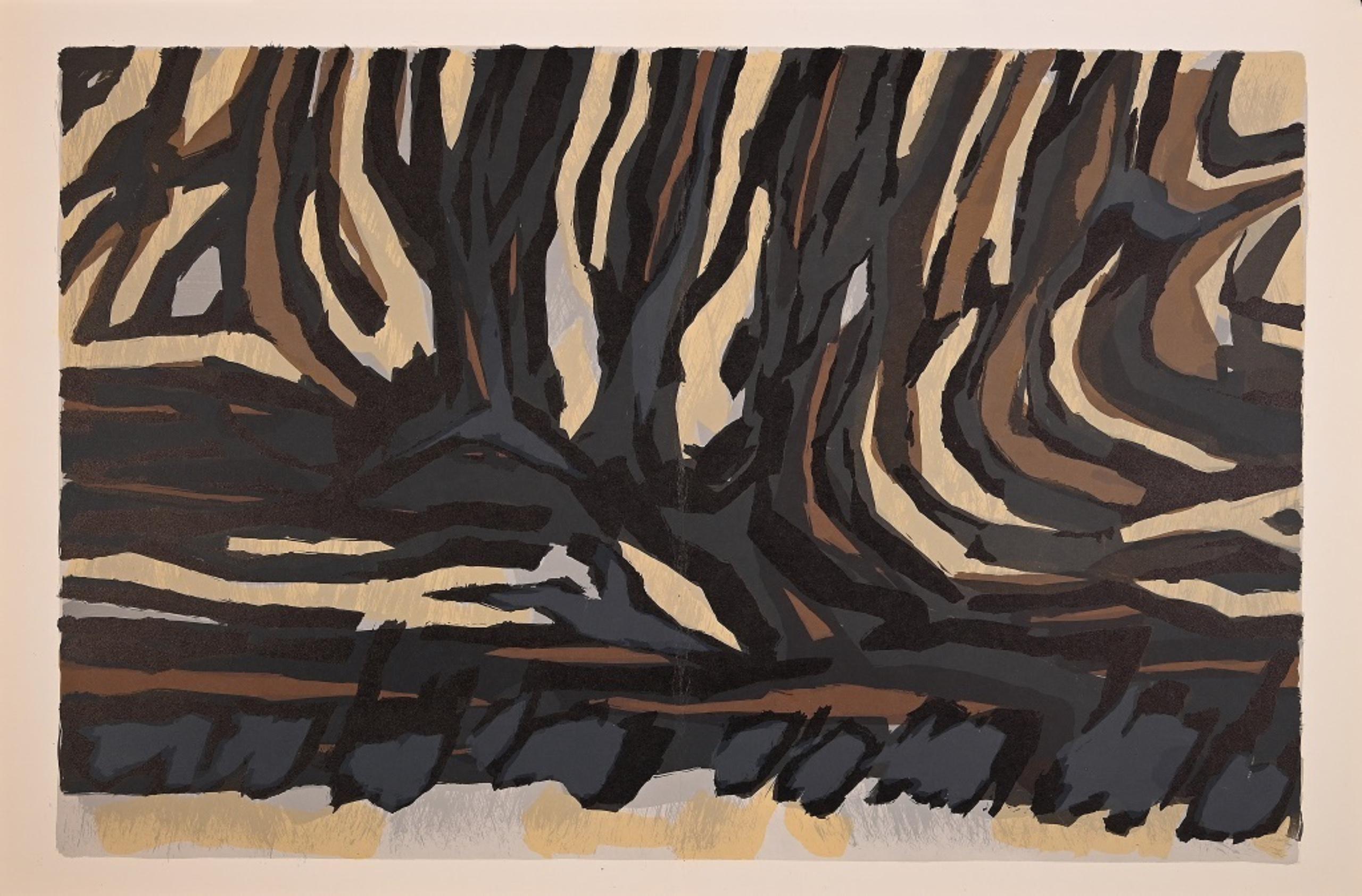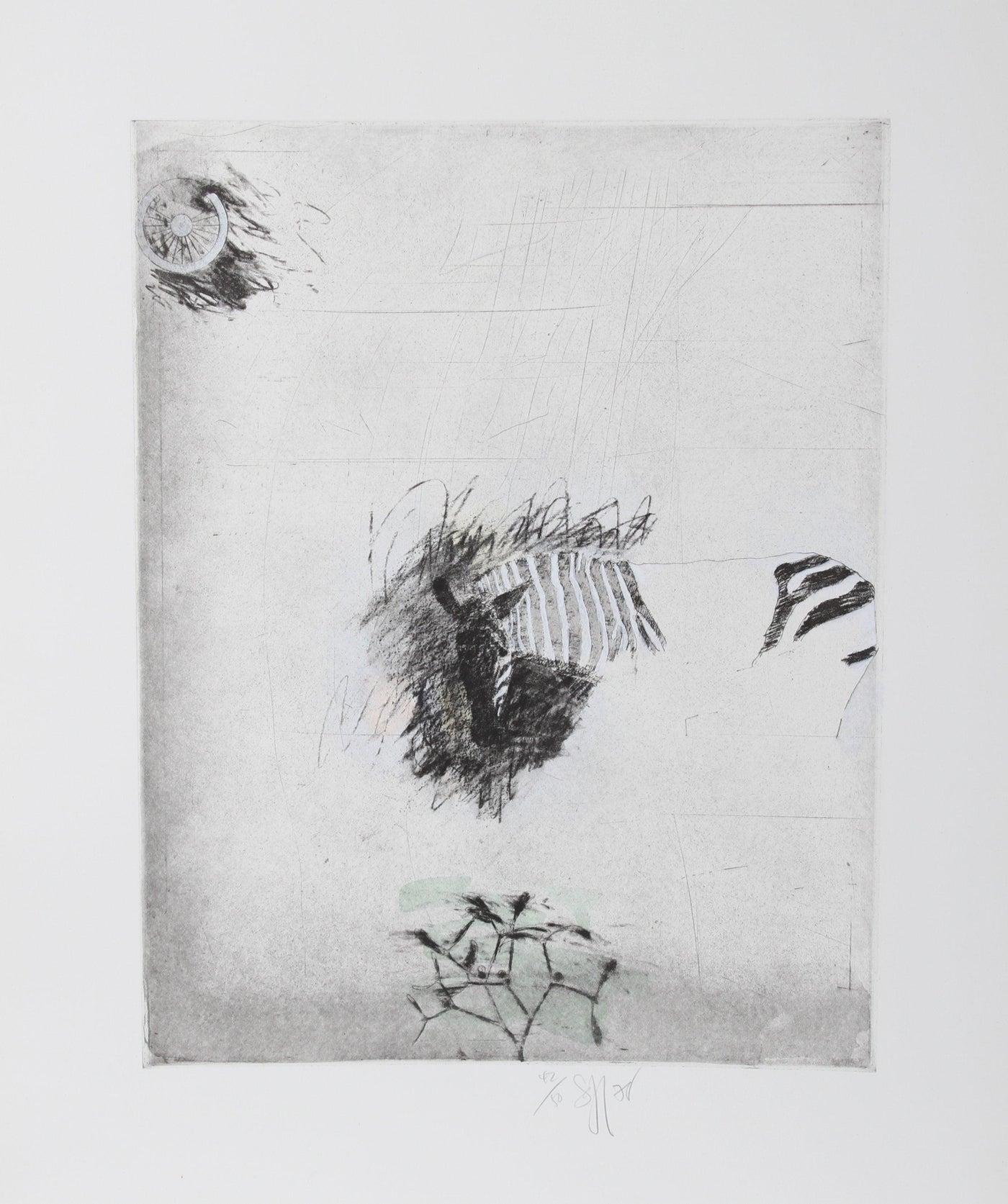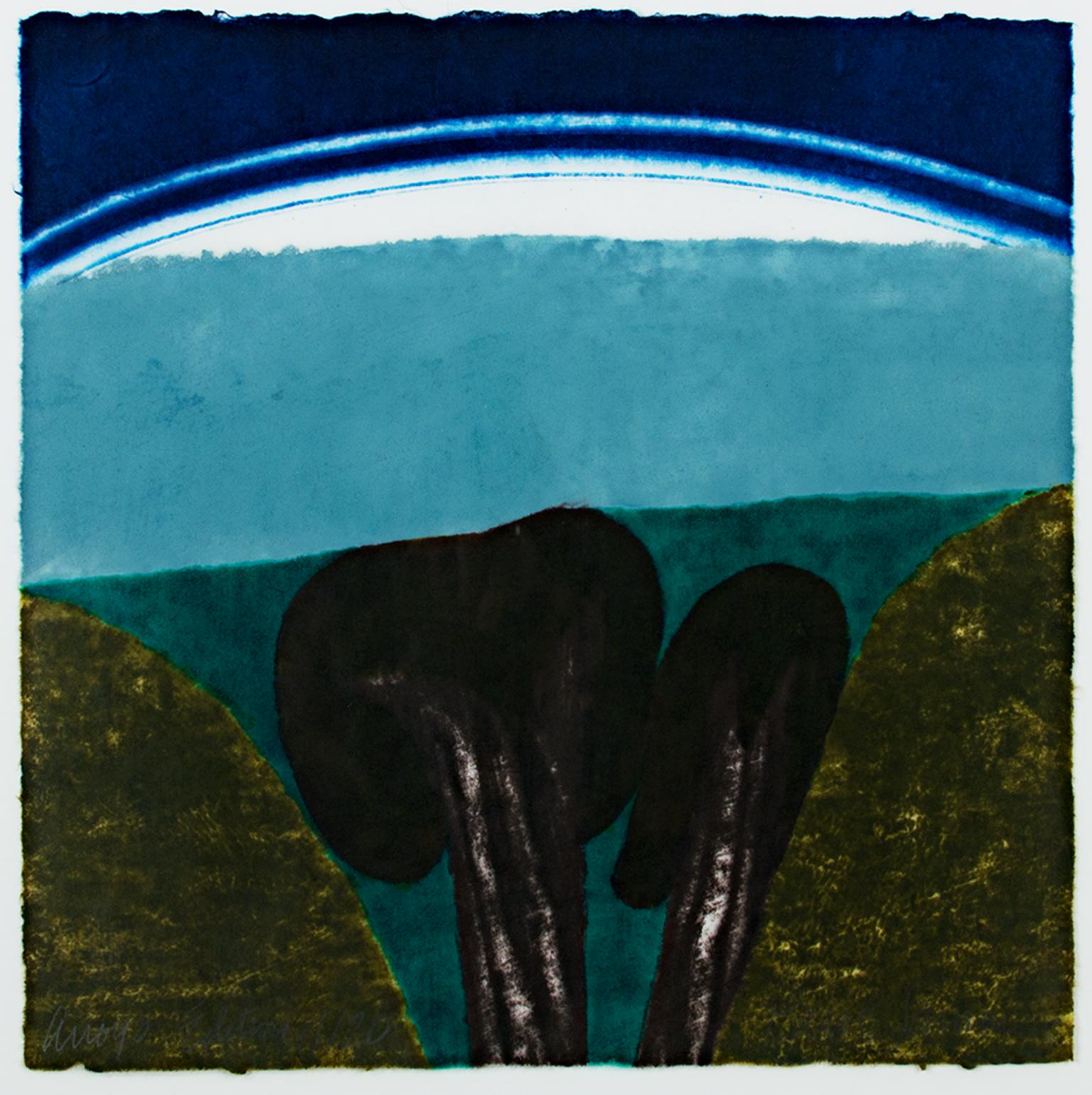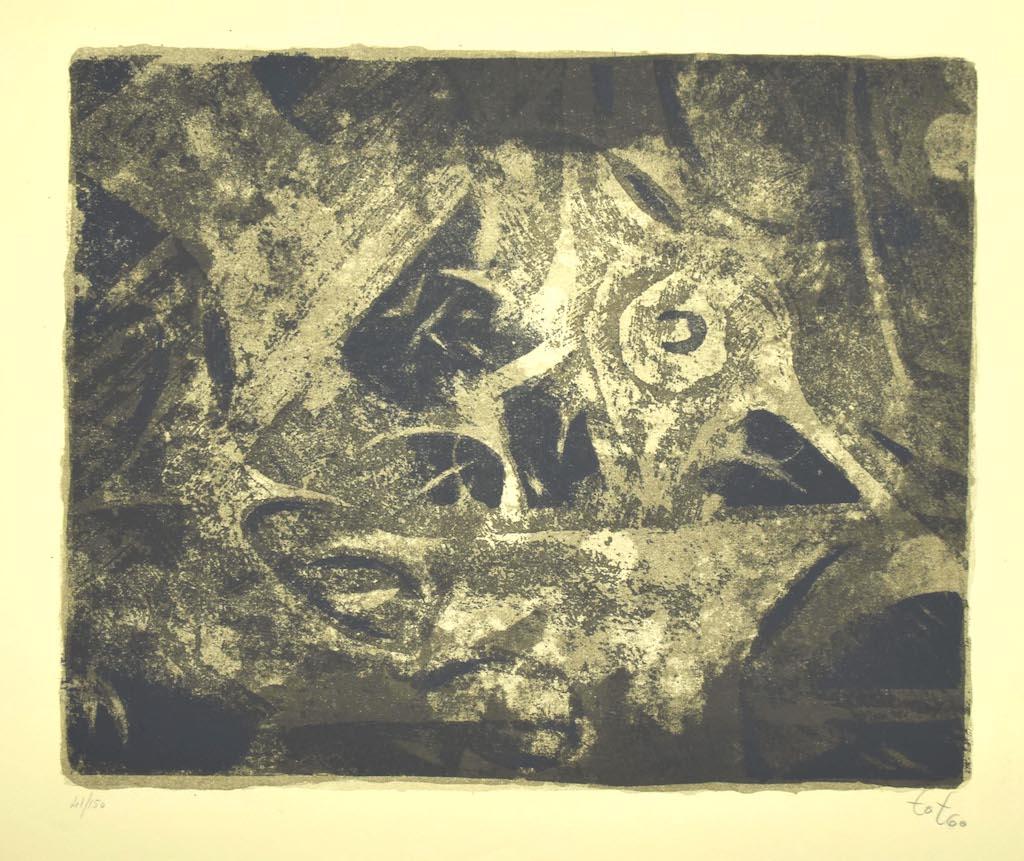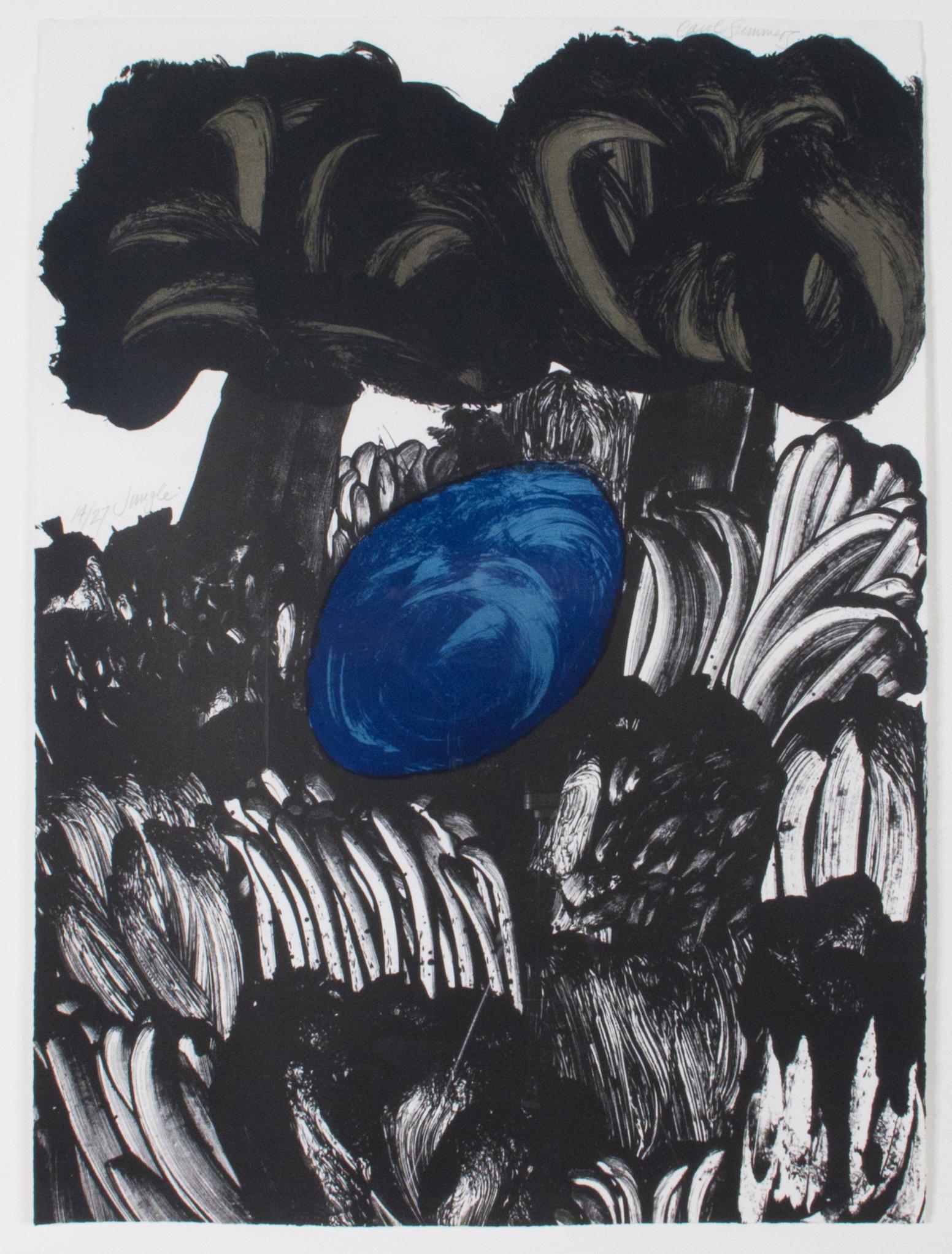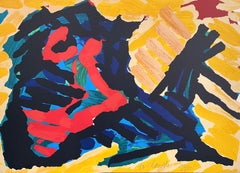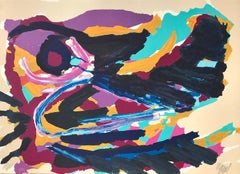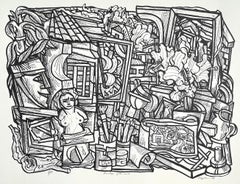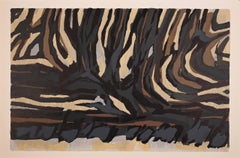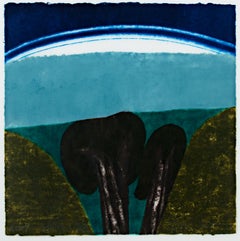Items Similar to BACK TO EARTH Signed Lithograph, Abstract Landscape, Zebra, Crescent Moon, Grass
Video Loading
Want more images or videos?
Request additional images or videos from the seller
1 of 13
Margo HumphreyBACK TO EARTH Signed Lithograph, Abstract Landscape, Zebra, Crescent Moon, Grass1968
1968
$2,500
£1,952.70
€2,213.62
CA$3,584.03
A$3,931.49
CHF 2,057.01
MX$46,792.50
NOK 25,981.34
SEK 24,370.96
DKK 16,532.53
About the Item
BACK TO EARTH is an original hand drawn lithograph by the American woman artist printmaker Margo Humphrey printed using hand lithography methods on archival Arches printmaking paper in 1968. BACK TO EARTH depicts a vertical abstract landscape printed in bold black, bright blue, chrome yellow, warm orange red, and teal green. BACK TO EARTH draws the viewer's attention with a series of three painted zebra images positioned in thirds from top to bottom within the composition moving from a dark night sky with crescent moons down to the earth referenced by the spiky green grassy area. BACK TO EARTH presents a very imaginative and painterly storybook expression by the renowned African American printmaker Margo Humphrey.
Print size - 23.75 x 12 in., unframed, good condition, margins trimmed, archival hinge mounting tape on reverse, hand signed in pencil by Margo Humphrey, numbered on lower left corner 3/5, titled - Back to Earth, signature and year '68 located on the lower right.
Note on ZEBRAS: Zebras have been featured in African art and culture for millennia. They are depicted in rock art in Southern Africa dating from 28,000 to 20,000 years ago, though not as commonly as antelope species like eland. How the zebra got its stripes has been the subject of folk tales, some of which involve it being scorched by fire. The Maasai proverb "a man without culture is like a zebra without stripes" has become popular in Africa and beyond. The San people associated zebra stripes with water, rain and lighting because of its dazzling pattern, and water spirits were conceived of having zebra stripes.Zebras once roamed all habitats in Africa, with the exceptions of rain forests, deserts, and dunes. Threats for all of them include habitat loss resulting from drought associated with climate change and farming, continuing political upheaval, and hunting.
Margo Humphrey (born Oakland, CA 1942) is an American printmaker, illustrator and art teacher. She earned a Master of Fine Arts degree from Stanford after earning a Bachelor of Fine Arts degree at the California College of Arts and Crafts in printmaking. She has traveled in Africa, Brazil, the Caribbean, and Europe and has taught in Fiji, Nigeria, Uganda, and the University of Maryland. She was awarded an undergraduate Fellowship to The Whitney Museum of American Art Summer Program in 1971. Humphrey earned a BFA in Painting and Printmaking and a MFA in Printmaking. She was one of the first African American women to distinguish herself in lithography. As a printmaker, she is known for her "bold, expressive use of color and freedom of form", creating works that are "engaging, exuberant and alive." Her techniques for layering colors are uncommon in lithography. Her work is considered to be "in the forefront of contemporary printmaking."
Artist bio - Wikipedia
Margo Humphrey’s many awards include The World Print Council’s James D. Pheland Award; two NEA and Tiffany Foundation Fellowship; a Ford Foundation Fellowship; and National Research Council and National Academy of Sciences Grants, among others. In addition to dozens of group shows, Humphrey’s solo exhibits have been hosted by the San Francisco Museum of Modern Art, the Santa Cruz County Museum, the Philadelphia Print Club, and the universities of Delaware, New Mexico, Nebraska, Texas at San Antonio, and California at Davis and Santa Cruz. In addition, a dozen major public collections are repositories of her art including the MoMA, Hampton University, the Smithsonian, the Oakland Museum of California, the Cincinnati Museum, and the Victoria and Albert Museum in London.
- Creator:Margo Humphrey (1942, American)
- Creation Year:1968
- Dimensions:Height: 23.75 in (60.33 cm)Width: 12 in (30.48 cm)
- Medium:
- Movement & Style:
- Period:
- Condition:Good condition, unframed, trimmed margin, archival hinge mounting tape on reverse, hand signed in pencil by the artist numbered 3/15, titled, dated '68 on lower right margin, strong impression.
- Gallery Location:Union City, NJ
- Reference Number:1stDibs: LU83239853702
About the Seller
4.9
Platinum Seller
Premium sellers with a 4.7+ rating and 24-hour response times
Established in 1975
1stDibs seller since 2018
708 sales on 1stDibs
Typical response time: <1 hour
- ShippingRetrieving quote...Shipping from: Union City, NJ
- Return Policy
More From This Seller
View AllRUNNING HORSE Signed Lithograph, Abstract Animal, CoBrA Artist
By Karel Appel
Located in Union City, NJ
RUNNING HORSE is an original hand drawn, limited edition lithograph by the Dutch artist Karel Appel printed using hand lithography techniques on Arches paper, 100% acid free.
RUNNING...
Category
1970s Abstract Abstract Prints
Materials
Lithograph
$1,680 Sale Price
21% Off
VILLA NEUVE Signed Lithograph, Modernist Abstract, City Landscape, Collage, Flag
By Conrad Marca-Relli 1
Located in Union City, NJ
VILLA NEUVE is an original limited edition lithograph printed using hand lithography techniques on archival printmaking paper 100% acid free. VILLA NEUVE is an imaginative modernist ...
Category
1980s Abstract Expressionist Abstract Prints
Materials
Lithograph
NESTING BIRD Signed Lithograph, Abstract Bird, Black Turquoise Purple Yellow
By Karel Appel
Located in Union City, NJ
NESTING BIRD is an original limited edition lithograph by the Dutch artist Karel Appel printed using hand lithography techniques on Arches paper, 100% acid free. NESTING BIRD is a li...
Category
1970s Abstract Animal Prints
Materials
Lithograph
$1,440 Sale Price
49% Off
LANDSCAPE OF THE MIND Signed Lithograph, Memorabilia, Black and White Abstract
By Marius Sznajderman
Located in Union City, NJ
Landscapes of The Mind is an original hand drawn, limited edition lithograph by Marius Sznajderman(Born-Paris,France 1926-2018) printed in black ink on white archival Arches paper, 100% acid-free, using traditional hand lithography printmaking methods. Landscapes of The Mind is a crisp, black and white abstract line drawing of artist memorabilia items within an attic-like interior illustrating various elements incuding faces, a sculpted female nude torso, artist paint brushes...
Category
1980s Contemporary Abstract Prints
Materials
Lithograph
GRAY AND BLACK ABSTRACT 2002 Signed Lithograph, John Ashbery Suite A WAVE Poem
By Will Barnet
Located in Union City, NJ
GRAY AND BLACK ABSTRACT by the American painter and printmaker Will Barnet is an original hand drawn lithograph, printed using hand lithography on archival printmaking paper 100% aci...
Category
Early 2000s Contemporary Abstract Prints
Materials
Lithograph
EVENING WALK Signed Lithograph, Abstract Animal Beige, Yellow, Plum, Blue, Green
By Karel Appel
Located in Union City, NJ
EVENING WALK is an original limited edition lithograph by the Dutch artist Karel Appel printed using hand lithography techniques on Arches paper, 100% acid free. EVENING WALK is a li...
Category
1980s Abstract Abstract Prints
Materials
Lithograph
You May Also Like
Striped Composition - Original Lithograph by Raoul Ubac - 1964
By Raoul Ubac
Located in Roma, IT
Striped Composition is an original lithograph realized by Raoul Ubac for the Art Magazine Derrière Le Miroir 142, in 1964 .
Printed by Ateliers de Maeght, Paris, 1964.
Good conditi...
Category
1960s Abstract Abstract Prints
Materials
Paper, Lithograph
Zebra (Color), Etching by Donald Saff
By Donald Saff
Located in Long Island City, NY
Zebra (Color)
Donald Saff, American (1937)
Date: 1980
Etching, signed and numbered in pencil
Edition of 50
Image Size: 24 x 18.5 inches
Size: 39 in. x 27.5 in. (99.06 cm x 69.85 cm)
Category
1980s Conceptual Prints and Multiples
Materials
Etching
Zebra, Etching by Donald Saff
By Donald Saff
Located in Long Island City, NY
Zebra
Donald Saff, American (1937)
Date: 1980
Etching, signed and numbered in pencil
Edition of 50
Image Size: 24 x 18.5 inches
Size: 39 in. x 27.5 in. (99.06 cm x 69.85 cm)
Category
1980s Conceptual Prints and Multiples
Materials
Etching
"Arroyo, " Original Woodcut and Monotype signed by Carol Summers
By Carol Summers
Located in Milwaukee, WI
"Arroyo" is an original woodcut and monotype by Carol Summers. The artist signed the piece. It is from an edition of 120 and depicts an abstract landscape in blues and greens.
14 1...
Category
1980s Abstract Expressionist Landscape Prints
Materials
Monotype, Woodcut
Composition - Original Lithograph by Amerigo Tot - 1960s
Located in Roma, IT
Composition is an original modern artwork realized by the Hungarian artist Amerigo Tot (Fehérvárcsurgó, 1909 - Rome, 1984) in 1960s.
Original Lithograph ...
Category
1960s Abstract Abstract Prints
Materials
Lithograph
"Jungle, " Color Lithograph Landscape signed by Carol Summers
By Carol Summers
Located in Milwaukee, WI
"Jungle" is an important, rare color lithograph signed by Carol Summers from the early years of his production. The image offers a landscape of a dark jungle, printed mostly in black ink. In the center, a blue pool of water is shaded by two trees. Summers' technique in this print renders a painterly quality to the image: the grasses and leaves of the scene are all created with playful, energetic swiping motions much like watercolor paint. This technique and the use of fields of color predict the style Summers would adopt in the coming decades, making this an important early work.
30 x 22 inches, artwork
Numbered 14 of the edition of 27
Carol Summers (1925-2016) has worked as an artist throughout the second half of the 20th century and into the first years of the next, outliving most of his mid-century modernist peers. Initially trained as a painter, Summers was drawn to color woodcuts around 1950 and it became his specialty thereafter. Over the years he has developed a process and style that is both innovative and readily recognizable. His art is known for it’s large scale, saturated fields of bold color, semi-abstract treatment of landscapes from around the world and a luminescent quality achieved through a printmaking process he invented.
In a career that has extended over half a century, Summers has hand-pulled approximately 245 woodcuts in editions that have typically run from 25 to 100 in number. His talent was both inherited and learned. Born in 1925 in Kingston, a small town in upstate New York, Summers was raised in nearby Woodstock with his older sister, Mary. His parents were both artists who had met in art school in St. Louis. During the Great Depression, when Carol was growing up, his father supported the family as a medical illustrator until he could return to painting. His mother was a watercolorist and also quite knowledgeable about the different kinds of papers used for various kinds of painting. Many years later, Summers would paint or print on thinly textured paper originally collected by his mother.
From 1948 to 1951, Carol Summers trained in the classical fine and studio arts at Bard College and at the Art Students League of New York. He studied painting with Steven Hirsh and printmaking with Louis Schanker. He admired the shapes and colors favored by early modernists Paul Klee (Sw: 1879-1940) and Matt Phillips (Am: b.1927- ). After graduating, Summers quit working as a part-time carpenter and cabinetmaker (which had supported his schooling and living expenses) to focus fulltime on art. That same year, an early abstract, Bridge No. 1 was selected for a Purchase Prize in a competition sponsored by the Brooklyn Museum.
In 1952, his work (Cathedral, Construction and Icarus) was shown the first time at the Museum of Modern Art in New York City in an exhibition of American woodcuts. In 1954, Summers received a grant from the Italian government to study for a year in Italy. Woodcuts completed soon after his arrival there were almost all editions of only 8 to 25 prints, small in size, architectural in content and black and white in color. The most well-known are Siennese Landscape and Little Landscape, which depicted the area near where he resided. Summers extended this trip three more years, a decision which would have significant impact on choices of subject matter and color in the coming decade.
After returning from Europe, Summers’ images continued to feature historical landmarks and events from Italy as well as from France, Spain and Greece. However, as evidenced in Aetna’s Dream, Worldwind and Arch of Triumph, a new look prevailed. These woodcuts were larger in size and in color. Some incorporated metal leaf in the creation of a collage and Summers even experimented with silkscreening. Editions were now between 20 and 50 prints in number. Most importantly, Summers employed his rubbing technique for the first time in the creation of Fantastic Garden in late 1957.
Dark Vision of Xerxes, a benchmark for Summers, was the first woodcut where Summers experimented using mineral spirits as part of his printmaking process. A Fulbright Grant as well as Fellowships from the Louis Comfort Tiffany Foundation and the Guggenheim Foundation followed soon thereafter, as did faculty positions at colleges and universities primarily in New York and Pennsylvania. During this period he married a dancer named Elaine Smithers with whom he had one son, Kyle. Around this same time, along with fellow artist Leonard Baskin, Summers pioneered what is now referred to as the “monumental” woodcut. This term was coined in the early 1960s to denote woodcuts that were dramatically bigger than those previously created in earlier years, ones that were limited in size mostly by the size of small hand-presses. While Baskin chose figurative subject matter, serious in nature and rendered with thick, striated lines, Summers rendered much less somber images preferring to emphasize shape and color; his subject matter approached abstraction but was always firmly rooted in the landscape.
In addition to working in this new, larger scale, Summers simultaneously refined a printmaking process which would eventually be called the “Carol Summers Method” or the “ Carol Summers Technique”. Summers produces his woodcuts by hand, usually from one or more blocks of quarter-inch pine, using oil-based printing inks and porous mulberry papers. His woodcuts reveal a sensitivity to wood especially its absorptive qualities and the subtleties of the grain. In several of his woodcuts throughout his career he has used the undulating, grainy patterns of a large wood plank to portray a flowing river or tumbling waterfall. The best examples of this are Dream, done in 1965 and the later Flash Flood Escalante, in 2003. In the majority of his woodcuts, Summers makes the blocks slightly larger than the paper so the image and color will bleed off the edge.
Before printing, he centers a dry sheet of paper over the top of the cut wood block or blocks, securing it with giant clips. Then he rolls the ink directly on the front of the sheet of paper and pressing down onto the dry wood block or reassembled group of blocks. Summers is technically very proficient; the inks are thoroughly saturated onto the surface of the paper but they do not run into each other. The precision of the color inking in Constantine’s Dream in 1969 and Rainbow Glacier in 1970 has been referred to in various studio handbooks. Summers refers to his own printing technique as “rubbing”. In traditional woodcut printing, including the Japanese method, the ink is applied directly onto the block. However, by following his own method, Summers has avoided the mirror-reversed image of a conventional print and it has given him the control over the precise amount of ink that he wants on the paper. After the ink is applied to the front of the paper, Summers sprays it with mineral spirits, which act as a thinning agent. The absorptive fibers of the paper draw the thinned ink away from the surface softening the shapes and diffusing and muting the colors. This produces a unique glow that is a hallmark of the Summers printmaking technique. Unlike the works of other color field artists or modernists of the time, this new technique made Summers’ extreme simplification and flat color areas anything but hard-edged or coldly impersonal.
By the 1960s, Summers had developed a personal way of coloring and printing and was not afraid of hard work, doing the cutting, inking and pulling himself. In 1964, at the age of 38, Summers’ work was exhibited for a second time at the Museum of Modern Art. This time his work was featured in a one-man show and then as one of MOMA’s two-year traveling exhibitions which toured throughout the United States. In subsequent years, Summers’ works would be exhibited and acquired for the permanent collections of multiple museums throughout the United States, Europe and Asia. Summers’ familiarity with landscapes throughout the world is firsthand. As a navigator-bombardier in the Marines in World War II, he toured the South Pacific and Asia.
Following college, travel in Europe and subsequent teaching positions, in 1972, after 47 years on the East Coast, Carol Summers moved permanently to Bonny Doon in the Santa Cruz Mountains in Northern California. There met his second wife, Joan Ward Toth, a textile artist who died in 1998; and it was here his second son, Ethan was born. During the years that followed this relocation, Summers’ choice of subject matter became more diverse although it retained the positive, mostly life-affirming quality that had existed from the beginning. Images now included moons, comets, both sunny and starry skies, hearts and flowers, all of which, in one way or another, remained tied to the landscape.
In the 1980s, from his home and studio in the Santa Cruz mountains, Summers continued to work as an artist supplementing his income by conducting classes and workshops at universities in California and Oregon as well as throughout the Mid and Southwest. He also traveled extensively during this period hiking and camping, often for weeks at a time, throughout the western United States and Canada. Throughout the decade it was not unusual for Summers to backpack alone or with a fellow artist into mountains or back country for six weeks or more at a time. Not surprisingly, the artwork created during this period rarely departed from images of the land, sea and sky. Summers rendered these landscapes in a more representational style than before, however he always kept them somewhat abstract by mixing geometric shapes with organic shapes, irregular in outline. Some of his most critically acknowledged work was created during this period including First Rain, 1985 and The Rolling Sea, 1989. Summers received an honorary doctorate from his alma mater, Bard College in 1979 and was selected by the United States Information Agency to spend a year conducting painting and printmaking workshops at universities throughout India. Since that original sabbatical, he has returned every year, spending four to eight weeks traveling throughout that country.
In the 1990s, interspersed with these journeys to India have been additional treks to the back roads and high country areas of Mexico, Central America, Nepal, China and Japan. Travel to these exotic and faraway places had a profound influence on Summers’ art. Subject matter became more worldly and nonwestern as with From Humla to Dolpo, 1991 or A Former Life of Budha, 1996, for example. Architectural images, such as The Pillars of Hercules, 1990 or The Raja’s Aviary, 1992 became more common. Still life images made a reappearance with Jungle Bouquet in 1997. This was also a period when Summers began using odd-sized paper to further the impact of an image.
The 1996 Night, a view of the earth and horizon as it might be seen by an astronaut, is over six feet long and only slightly more than a foot-and-a-half high. From 1999, Revuelta A Vida (Spanish for “Return to Life”) is pie-shaped and covers nearly 18 cubic feet. It was also at this juncture that Summers began to experiment with a somewhat different palette although he retained his love of saturated colors. The 2003 Far Side of Time is a superb example of the new direction taken by this colorist.
At the turn of the millennium in 1999, “Carol Summers Woodcuts...
Category
1960s Contemporary Landscape Prints
Materials
Lithograph
More Ways To Browse
Signed Humphrey
Irish Water Spaniel
Jack Coughlin
John Gould Ducks
Keith Haring Secret Pastures
Kenojuak Ashevak
Le Singe Et Le Leopard
Leon Danchin On Sale
Louis Prang Chromolithograph
Man O War Horse
Manetti Saverio
Natural History Museum Vintage Prints
Penguin Lithograph
Peter Klucik
Pheasant Engraving
Picasso Dove Of Peace
Picasso Le Taureau
Picasso Rooster
